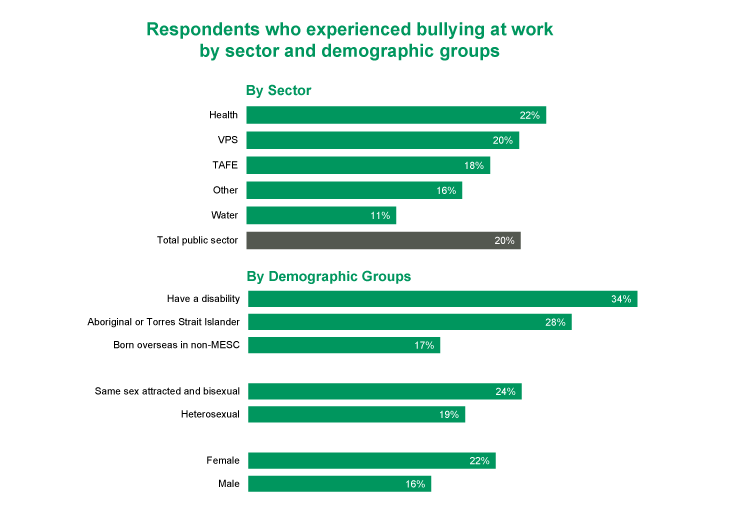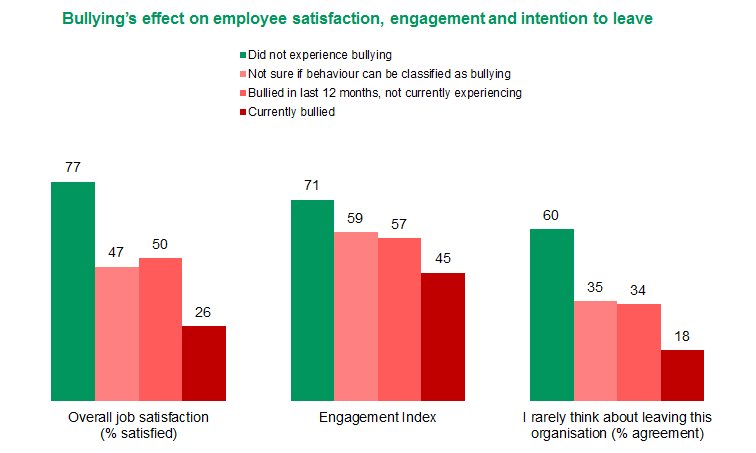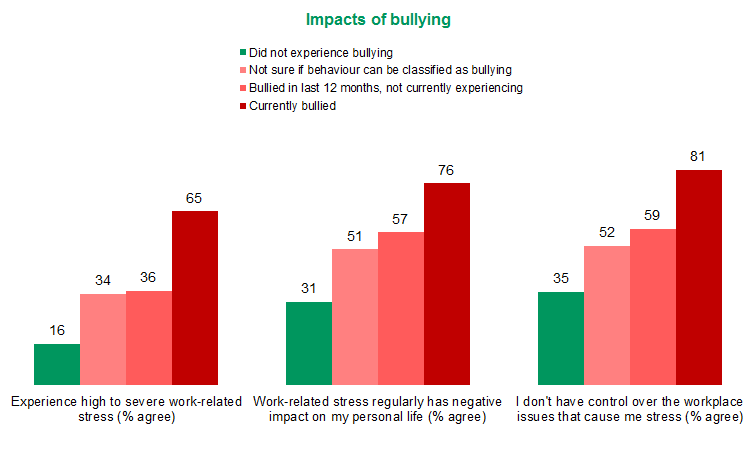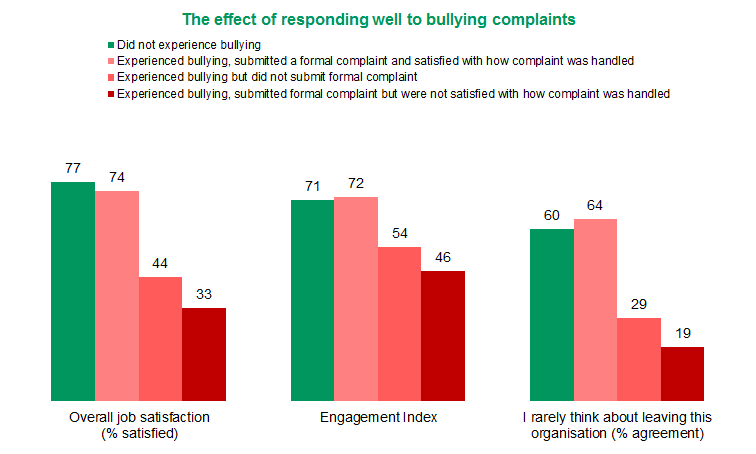Bullying is an issue of particular concern for all workplaces. Public sector bullying has become the focus of increased attention by government in recent times. It has significant negative impacts on both individual and workplace health and wellbeing and also affects the productivity of organisations.
Incidence of bullying
The total cost of workplace bullying in Australia is estimated to be between $6 billion and $36 billion annually.[1] However beyond the financial costs and lost productivity impacts, the most profound effects can be on a person’s health, their work and their family life.
People Matter Survey results over the past ten years reveal that around one in four people witness what they believe to be bullying and one in five experience behaviour that feels like bullying. Figure 1 shows that perceptions of bullying are higher in the health sector and that people with a disability experience the highest incidence.

Figure 1 – Respondents who experienced bullying at work by sector and demographic groups[2]
View text version of Figure 1 bar chart
The damage that bullying can do
Job satisfaction is significantly lower among employees experiencing bullying, with 26 per cent satisfied with their job overall, compared with 77 per cent of those who have not experienced bullying (Figure 2). Similarly, employees experiencing bullying are three times as likely to think about leaving their organisation.

Figure 2 – Bullying’s effect on employee satisfaction, engagement and intention to leave
View text version of Figure 2 bar chart
The effect of bullying endures after it stops. Those who indicate that they experienced bullying during the past 12 months, but are not currently doing so, are still less positive than those who have not experienced bullying at all. This supports qualitative research findings that negative workplace behaviour damages trust in the organisation and can make negative perceptions of even relatively benign behaviour more likely.[4]
Bullying negatively impacts on employee wellbeing. Work-related stress is significantly higher among those experiencing bullying with 65 per cent experiencing high to severe stress, compared with 16 per cent of those who did not experience bullying (Figure 3). Similarly, 76 per cent of those experiencing bullying indicate that work-related stress regularly has a negative impact on their personal life, with 81 per cent indicating that they don’t have control over the workplace issues that cause them stress. This compares to 31 per cent and 35 per cent, respectively, of those who did not experience bullying.

Figure 3 – Impacts of bullying
View text version of Figure 3 bar chart
Responding well to complaints of bullying
Employees who submit a bullying complaint and are satisfied with the way their complaint is handled are almost as positive about their workplaces as those who have not experienced bullying at all (Figure 4). This suggests that responding well to complaints of bullying has a powerful effect, ameliorating some of the damage of workplace bullying.

Figure 4 – The effect of responding well to bullying complaints
Note: this chart uses the Engagement Index. More information can be found in [Note 3]
View text version of Figure 4 bar chart
Encouraging people to speak up is a vital first step
Organisations need to ensure that employees are aware of, and have confidence in, grievance processes and that these processes produce fair outcomes. There is still much work to be done in this area as:
- only 53 per cent of respondents indicate that they were confident that if they lodge a grievance it would be investigated in a thorough and objective manner;
- of those who experienced bullying, only 19 per cent submitted a formal complaint; and
- of those who submitted a formal bullying complaint, only 26 per cent were satisfied with how their complaint was handled.
Tackling Bullying
The VPSC is currently working with an advisory group to address bullying in the public sector. This group, comprising employers and unions is considering strategies to reduce bullying, as well as policies and practices that make a positive difference to the work environment.
Additionally, the Department of Health and Human Services has developed a new strategy to eliminate bullying and harassment in the healthcare sector. Titled Our pathway to change: eliminating bulling and harassment in healthcare, the strategy will promote and drive a consistent, system-wide approach to facilitating cultural change, addressing bullying and harassment, and ensuring equity and diversity in the sector.[5]
Access DHHS’s resource “Our pathway to change: eliminating bullying and harassment in healthcare”
VPSC resources for dealing with bullying
The VPSC has produced a number of tools and guides for dealing with negative behaviours in the workplace. This includes resources on managing poor behaviour in workplaces and guides on how to create a positive work environment in your organisation.
Visit VPSC’s Bullying resources
View the source data as an excel spreadsheet (XLSX, 13KB)
Download Bullying in the Public Sector (PDF, 117KB, 7pages)
About the People Matter SurveyThe People Matter Survey gauges Victorian public sector employee perceptions of their workplaces. The 2016 survey was conducted during May-July 2016. A total of 62,354 staff employed by 177 public sector organisations participated in the survey, achieving an overall response rate of 35 percent. The survey currently includes a core component of questions and six optional modules focusing on specific topics. Not all organisations participating in the survey choose to complete all modules and therefore the number of responses analysed for different aspects of the survey will vary. |
Notes
The bullying analysis presented here is based on responses from 57,204 people employed across the public sector. Specific analysis on the impact of bullying on work-related stress is based on responses from 50,694 people who also completed the employee wellbeing module.
[1] Productivity Commission (2010). Performance Benchmarking of Australian Business Regulation: Occupational Health & Safety. Research Report, Canberra.
[2] This paper uses the Australian Bureau of Statistics (ABS) definition of ‘main English speaking countries’ (MESCs). According to the ABS, the ‘main English speaking countries’ are the main countries from which Australia has historically received significant numbers of overseas settlers who are likely to speak English. These countries comprise the United Kingdom, the Republic of Ireland, New Zealand, Canada, South Africa and the United States of America. Respondents ‘born overseas in non-MESC’ are people born overseas in other than the six countries listed here.
[3] Engagement Index: Each respondent is given a score for each engagement question where strongly agree equates to 100 points, agree equates to 75 points, neither agree nor disagree equates to 50 points,disagree equates to 25 points and strongly disagree equates to 0 points. The engagement index is the average score for the five engagement questions.
[4] State Services Authority (2013). Exploring workplace behaviours: from bullying to respect. Final report of the workplace behaviours project, State Government of Victoria, Melbourne.
[5] Department of Health and Human Services (2016). Our pathway to change: eliminating bullying and harassment in healthcare. Strategy, State Government of Victoria, Melbourne.
Figure descriptors
Figure 1: Respondents who experienced bullying at work by sector and demographic groups[2]
Bar chart demonstrating the proportion of respondents that indicated they have personally experienced bullying in the last 12 months, broken down by sector and personal characteristics. There are large variations between the different identifiers.
The chart has 13 identifiers separated into 2 groups – Sector, which has 6 identifiers; and Demographic groups, which has 7 identifiers. Numbers are expressed as a percentage of all responses, and may have been rounded up.
Sector
Health 22
VPS 20
TAFE 18
Other 16
Water 11
Total public sector 20
Demographic groups
Have a disability 34
Aboriginal or Torres Strait Islander 28
Born overseas in non-MESC 17
Same sex attracted and bisexual 24
Heterosexual 19
Female 22
Male 16
Figure 2: Bullying’s effect on employee satisfaction, engagement and intention to leave
Column chart demonstrating the impact of bullying on employee satisfaction, engagement and intentions to leave. There a clear trend that shows that those who are currently being bullied have much lower Overall job satisfaction, lower engagement, and lower agreement with the statement ‘I rarely think about leaving this organisation’ than those who did not experience bullying in the last 12 months.
The chart has 4 identifiers – Did not experience bullying, Not sure if behaviour can be classified as bullying, Bullied in the last 12 months but not currently experiencing, and Currently bullied. These identifiers are duplicated over 3 categories of response – Overall job satisfaction (% satisfied), Engagement Index, and I rarely think about leaving this organisation (% agreement). Numbers are expressed as either a percentage of all responses, or the Engagement Index, and may have been rounded up. Note: this chart uses the Engagement Index. More information can be found in [Note 3]
Overall job satisfaction (% satisfied)
Did not experience bullying 77
Not sure if behaviour can be classified as bullying 47
Bullied in the last 12 months but not currently experiencing 50
Currently bullied 26
Engagement Index3
Did not experience bullying 71
Not sure if behaviour can be classified as bullying 59
Bullied in the last 12 months but not currently experiencing 57
Currently bullied 45
I rarely think about leaving this organisation (% agreement)
Did not experience bullying 60
Not sure if behaviour can be classified as bullying 35
Bullied in the last 12 months but not currently experiencing 34
Currently bullied 18
Figure 3: Impacts of bullying
Column chart demonstrating the impact of bullying on employee’s wellbeing. There is a clear trend that shows that those who are currently being bullied have much higher numbers of those experiencing high to severe work-related stress, that work-related stress regularly has a negative impact on their personal lives, and that they don’t have control over the workplace issues that cause them stress, compared to those who did not experience bullying in the last 12 months.
The chart has 4 identifiers – Did not experience bullying, Not sure if behaviour can be classified as bullying, Bullied in the last 12 months but not currently experiencing, and Currently bullied. These identifiers are duplicated over 3 categories of response – Experience high to severe work-related stress (% agree), Work-related stress regularly has a negative impact on my personal life (% agree), and I don’t have control over the workplace issues that cause me stress (% agree). Numbers are expressed as a percentage of all responses, and may have been rounded up.
Experience high to severe work-related stress (percentage agree)
Did not experience bullying 16
Not sure if behaviour can be classified as bullying 34
Bullied in the last 12 months but not currently experiencing 36
Currently bullied 65
Work-related stress regularly has a negative impact on my personal life (percentage agree)
Did not experience bullying 31
Not sure if behaviour can be classified as bullying 51
Bullied in the last 12 months but not currently experiencing 57
Currently bullied 76
I don’t have control over the workplace issues that cause me stress (percentage agree)
Did not experience bullying 35
Not sure if behaviour can be classified as bullying 52
Bullied in the last 12 months but not currently experiencing 59
Currently bullied 81
Figure 4: The effect that responding well to complaints can have
Column chart demonstrating the impact of the outcome of a bullying complaint on employee satisfaction, engagement and intentions to leave. Those who submitted a bullying complaint and were satisfied with how the complaint was handled have quite similar Overall job satisfaction, similar engagement, and similar agreement with the statement ‘I rarely think about leaving this organisation’ compared to those who did not experience bullying in the last 12 months.
The chart has 4 identifiers – Did not experience bullying, Experienced bullying submitted formal complaint and satisfied with how complaint was handled, Experienced bullying but did not submit formal complaint, Experienced bullying submitted formal complaint but were not satisfied with how complaint was handled. These identifiers are duplicated over 3 categories of response – Overall job satisfaction (percentage satisfied), Engagement Index, and I rarely think about leaving this organisation (percentage agreement). Numbers are expressed as either a percentage of all responses, or the Engagement Index, and may have been rounded up. Note: this chart uses the Engagement Index. More information can be found in [Note 3]
Overall job satisfaction (percentage satisfied)
Did not experience bullying 77
Experienced bullying, submitted formal complaint and satisfied with how complaint was handled 74
Experienced bullying but did not submit formal complaint 44
Experienced bullying submitted formal complaint but not satisfied with how complaint was handled 33
Engagement Index
Did not experience bullying 71
Experienced bullying, submitted formal complaint and satisfied with how complaint was handled 72
Experienced bullying but did not submit formal complaint 54
Experienced bullying submitted formal complaint but not satisfied with how complaint was handled 46
I rarely think about leaving this organisation (percentage agreement)
Did not experience bullying 60
Experienced bullying, submitted formal complaint and satisfied with how complaint was handled 64
Experienced bullying but did not submit formal complaint 29
Experienced bullying submitted formal complaint but not satisfied with how complaint was handled 19
